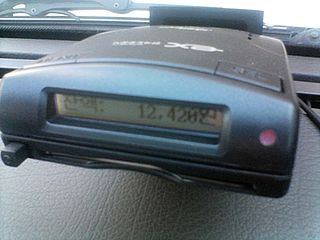Related Research Articles

The American Heritage Dictionary of the English Language (AHD) is a dictionary of American English published by Boston publisher Houghton Mifflin, the first edition of which appeared in 1969. Its creation was spurred by the controversy over the perceived permissiveness of the Webster's Third New International Dictionary. The third edition included over 350,000 entries and meanings.
The lexical definition of a term, also known as the dictionary definition, is the definition closely matching the meaning of the term in common usage. As its other name implies, this is the sort of definition one is likely to find in the dictionary. A lexical definition is usually the type expected from a request for definition, and it is generally expected that such a definition will be stated as simply as possible in order to convey information to the widest audience.
Flag information symbols are used by vexillologists to indicate certain characteristics of flags, such as where they are used, who uses them, and what they look like. The symbols were created by vexillologist Whitney Smith and then adopted by the International Federation of Vexillological Associations (FIAV) in the early 1970s. Vexillologist Željko Heimer added the symbols for normal and historical in the early 1990s.

.tf is the Internet country code top-level domain (ccTLD) for the French Southern and Antarctic Lands. Along with .fr, .pm, .re, .wf and .yt it is administered by AFNIC. Before 23 October 2004, Adamsnames, based in Cambridge in the United Kingdom, administered this TLD.

.sz is the Internet country code top-level domain (ccTLD) for Eswatini. The Eswatini ISP Association ("SISPA") is responsible for assigning .SZ domain names.

Kelvinhall is an underground station on the Glasgow Subway, renamed after the nearby Kelvin Hall. It is located in the West End of Glasgow, Scotland, near to many of the city's best known tourist destinations including:

Burnley Barracks railway station is in Burnley, England, on the East Lancashire Line 1⁄2-mile (800 m) west of Burnley Central railway station. Following the singling of the track in December 1986, Burnley Barracks has one platform in use, with only a basic shelter in place, and no other buildings on the platform.

Cowcaddens subway station serves the Cowcaddens area of Glasgow, Scotland. It is located on the north side of the city centre and is served by the Glasgow Subway.

Kelvinbridge subway station is a Glasgow Subway station serving the Woodlands, Woodside and Hillhead areas of Glasgow, Scotland. It is named after the bridge crossing the River Kelvin, next to the station. This station is one of the two serving Kelvingrove Park, the other being Kelvinhall.

Kinning Park subway station serves the Kinning Park area of Glasgow, Scotland. However, to reach Kinning Park, a footbridge is provided across the M8.

West Street subway station on the Glasgow Subway network serves the Tradeston and Kingston areas of Glasgow, Scotland.

Transcription factor 7 is the gene that in humans encodes for the TCF1 protein.

In English, a curriculum vitae is a short written summary of a person's career, qualifications, and education. This is the most common usage in British English. In North America, the term résumé is used, referring to a short career summary.

In common usage data is a collection of discrete or continuous values that convey information, describing the quantity, quality, fact, statistics, other basic units of meaning, or simply sequences of symbols that may be further interpreted formally. A datum is an individual value in a collection of data. Data is usually organized into structures such as tables that provide additional context and meaning, and which may themselves be used as data in larger structures. Data may be used as variables in a computational process. Data may represent abstract ideas or concrete measurements. Data is commonly used in scientific research, economics, and in virtually every other form of human organizational activity. Examples of data sets include price indices, unemployment rates, literacy rates, and census data. In this context, data represents the raw facts and figures from which useful information can be extracted.

The Jacksonville Dolphins baseball team represents Jacksonville University, which is located in Jacksonville, Florida. The Dolphins are an NCAA Division I college baseball program that competes in the Atlantic Sun Conference. They began competing in Division I in 1969 and joined the Atlantic Sun Conference in 1999 after 20 years in the Sun Belt Conference.

The Jacksonville Dolphins men's basketball team represents Jacksonville University in the sport of basketball. The Dolphins compete in NCAA Division I's ASUN Conference (ASUN). Home games are played in the historic Swisher Gymnasium on the campus of Jacksonville University.

Resource Monitor, a utility in Windows Vista and later, displays information about the use of hardware and software resources in real time. Users can launch Resource Monitor by executing resmon.exe.
Maltese Braille is the braille alphabet of the Maltese language. It was in the news in 2005 with the publication of the first braille Bible in Maltese.

Hi-pass is the name of a system for the expressways in South Korea that allows motorists to make wireless toll payments, without the need to stop.
The usage-based linguistics is a linguistics approach within a broader functional/cognitive framework, that emerged since the late 1980s, and that assumes a profound relation between linguistic structure and usage. It challenges the dominant focus, in 20th century linguistics, on considering language as an isolated system removed from its use in human interaction and human cognition. Rather, usage-based models posit that linguistic information is expressed via context-sensitive mental processing and mental representations, which have the cognitive ability to succinctly account for the complexity of actual language use at all levels. Broadly speaking, a usage-based model of language accounts for language acquisition and processing, synchronic and diachronic patterns, and both low-level and high-level structure in language, by looking at actual language use.
References
Studies in International Relations. Pulse Publications. 2006. p. 25. ISBN 0-948766-97-2.